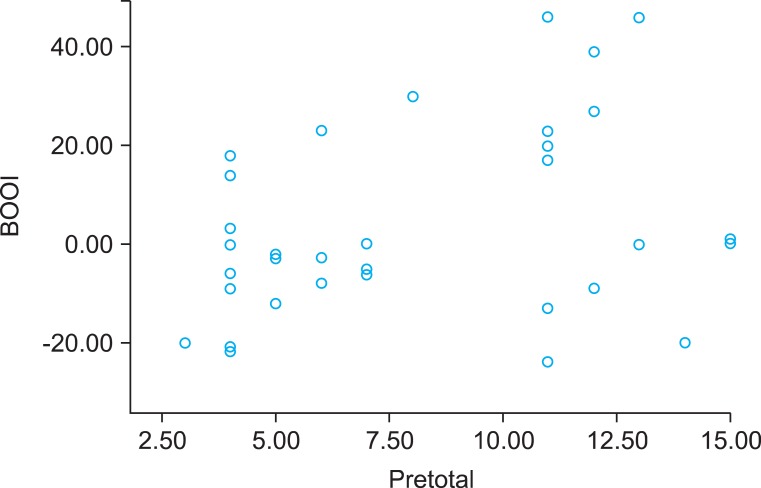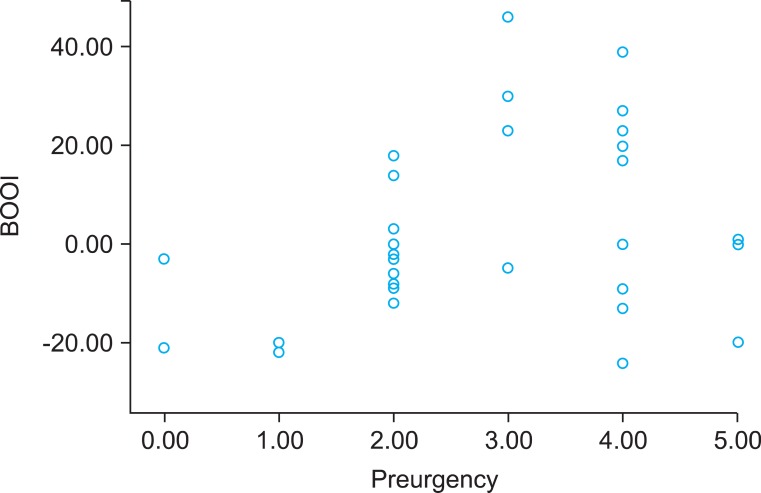Korean J Urol.
2012 Jun;53(6):405-409.
A Predictive Factor in Overactive Bladder Symptoms Improvement after Combined Anterior Vaginal Wall Prolapse Repair: A Pilot Study
- Affiliations
-
- 1Department of Urology, KEPCO Medical Foundation, Hanil General Hospital, Seoul, Korea. urohee@hanmail.net
Abstract
- PURPOSE
We aimed to determine whether a preoperative urodynamic parameter is a valuable predictor for the persistence of OAB symptoms after the AVP repair.
MATERIALS AND METHODS
65 OAB patients with concomitant POP-Q stage III, IV anterior vaginal wall prolapse underwent a surgical repair were involved. All the patients were subjected to a preoperative urodynamic study, for whom the OABSS on questionnaire were preoperatively recorded. We firstly analyzed the correlation between the BOOI and the OABSS, then randomly divided patients into two groups: the group A (high PdetQmax, BOOI> or =20) and the group B (low PdetQmax, BOOI<20). In each group, the OABSS was repeatedly measured post-operatively and the change were analyzed.
RESULTS
31 patients were classified as the group A and 34 patients were classified as the group B. The group B showed significant decrease of symptom score in daytime frequency (p<0.01), urgency (p=0.04), urge incontinence (p=0.03), nocturnal frequency (p=0.01) and total score (p=0.01). The group A showed no significant decrease of symptom score in daytime frequency (p=0.42), urgency (p=0.61), urge incontinence (p=0.3), total score (p=0.15) except nocturnal frequency (p=0.01).
CONCLUSIONS
A preoperative pressure-flow study can be a valuable tool in predicting the OAB symptoms change after the combined AVP repair. While the AVP repair leads to the improvement of OAB symptoms generally, some patients with a higher preoperative PdetQmax are still in need of the additional medical treatment.
MeSH Terms
Figure
Reference
-
1. de Boer TA, Cluivers KB, Withagen MI, Milani AL, Vierhout ME. Predictive factors for overactive bladder symptomsafter pelvic organ prolapse surgery. Int Urogynecol J. 2010; 21:1143–1149. PMID: 20419366.2. Lawrence JM, Lukacz ES, Nager CW, Hsu JW, Luber KM. Prevalence and co-occurrence of pelvic floor disorders in community-dwelling women. Obstet Gynecol. 2008; 111:678–685. PMID: 18310371.
Article3. Miedel A, Tegerstedt G, Maehle-Schmidt M, Nyrén O, Hammarström M. Symptoms and pelvic support defectsin specific compartments. Obstet Gynecol. 2008; 112:851–858. PMID: 18827128.4. Digesu GA, Salvatore S, Chaliha C, Athanasious S, Milani R, Khullar V. Do overactive bladder symptoms improve after repair of anterior vaginal wall prolapse? Int Urogynecol J Pelvic Floor Dysfunct. 2007; 18:1439–1443. PMID: 17429557.
Article5. Foster RT Sr, Barber MD, Parasio MF, Walters MD, Wekdner AC, Amundsen CL. A prospective assessment of overactive bladder symptoms in a cohort of elderly women who underwent transvaginal surgery for advanced pelvic organ prolapse. Am J Obstet Gynecol. 2007; 197:82.e1–82.e4. PMID: 17618768.
Article6. Stanton SL, Hilton P, Norton C, Cardozo L. Clinical and urodynamic effects of anterior colporrhaphy and vaginal hysterectomy for prolapse with and without incontinence. Br J Obstet Gynaecol. 1982; 89:459–463. PMID: 7082603.
Article7. Clemons JL, Aguilar VC, Tillinghast TA, Jackson ND, Myers DL. Patient satisfaction and changes in prolapse and urinary symptoms in women who were fitted successfully with a pessary for pelvic organ prolapse. Am J Obstet Gynecol. 2004; 190:1025–1029. PMID: 15118635.
Article8. Fernando RJ, Thakar R, Sultan AH, Shah SM, Jones PW. Effect of vaginal pessaries on symptoms associated with pelvic organ prolapse. Obstet Gynecol. 2006; 108:93–99. PMID: 16816061.
Article9. Hanson LA, Schulz JA, Flood CG, Cooley B, Tam F. Vaginal pessaries in managing women with pelvic organ prolapse and urinary incontinence: patient characteristics and factors contributing to success. Int Urogynecol J Pelvic Floor Dysfunct. 2006; 17:155–159. PMID: 16044204.
Article10. Fletcher SG, Haverkorn RM, Yan J, Lee JJ, Zimmern PE, Lemack GE. Demographic and urodynamic factors associated with persistent OAB after anterior compartment prolapse repair. Neurourol Urodyn. 2010; 29:1414–1418. PMID: 20623545.
Article11. Homma Y, Yoshida M, Seki N, Yokoyama O, Kakizaki H, Gotoh M, et al. Symptom assessment tool for overactive bladder syndrome-overactive bladder symptom score. Urology. 2006; 68:318–323. PMID: 16904444.
Article12. Gosling JA, Gilpin SA, Dixon JS, Gilpin CJ. Decrease in the autonomic innervations of human detrusor muscle in outflow obstruction. J Urol. 1986; 136:501–504. PMID: 3735523.13. Harrison SC, Hunnam GR, Farman P, Ferguson DR, Doyle PT. Bladder instability and denervation in patients with bladder outflow obstruction. Br J Urol. 1987; 60:519–522. PMID: 3427336.
Article14. Harrison SC, Ferguson DR, Doyle PT. Effect of bladder outflow obstruction on the innervation of the rabbit urinary bladder. Br J Urol. 1990; 66:372–379. PMID: 1699626.
Article15. Sibley GN. The physiological response of the detrusor muscle to experimental bladder outflow obstruction in the pig. Br J Urol. 1987; 60:332–336. PMID: 3690205.
Article16. Azadzoi KM, Pontari M, Vlachiotis J, Siroky MB. Canine bladder blood flow andoxygenation: changes induced by filling, contraction and outlet obstruction. J Urol. 1996; 155:1459–1465. PMID: 8632611.17. de Boer TA, Salvatore S, Cardozo L, Chapple C, Kelleher C, van Kerrebroeck P, et al. Pelvic organ prolapse and overactive bladder. Neurourol Urodyn. 2010; 29:30–39. PMID: 20025017.
Article18. Seki N, Karim OM, Mostwin JL. The effect of experimental urethral obstruction and its reversal on changes in passive electrical properties of detrusor muscle. J Urol. 1992; 148:1957–1961. PMID: 1331551.
Article19. Steers WD, de Groat WC. Effect of bladder outlet obstruction on micturition reflex pathways in the rat. J Urol. 1988; 140:864–871. PMID: 3418824.
Article20. Steers WD, Kolbeck S, Creedon D, Tuttle JB. Nerve growth factor in the urinary bladder of the adult regulates neuronal form and function. J Clin Invest. 1991; 88:1709–1715. PMID: 1939656.
Article21. Steers WD, Ciambotti J, Etzel B, Erdman S, de Groat WC. Alterations in afferent pathways from the urinary bladder of the rat in response to partial urethral obstruction. J Comp Neurol. 1991; 310:401–410. PMID: 1723990.
Article22. Ferguson DR, Kennedy I, Burton TJ. ATP is released from rabbit urinary bladder epithelial cells by hydrostatic pressure changes-a possible sensory mechanism? J Physiol. 1997; 505:503–511. PMID: 9423189.23. Sun Y, Chai TC. Up-regulation of P2X3 receptor during stretch of bladder urothelial cells from patients with interstitial cystitis. J Urol. 2004; 171:448–452. PMID: 14665953.24. Yoshida M, Inadome A, Maeda Y, Satoji Y, Masunaga K, Sugiyama Y, et al. Non-neuronal cholinergic system in human bladder urothelium. Urology. 2006; 67:425–430. PMID: 16461116.
Article25. Yuan Z, Shen H. Pelvic organ prolapse quantification in women referred with overactive bladder. Int Urogynecol J. 2010; 21:1365–1369. PMID: 20577715.
Article26. Klutke JJ, Ramos S. Urodynamic outcome after surgery for severe prolapse and potential stress incontinence. Am J Obstet Gynecol. 2000; 182:1378–1381. PMID: 10871452.
Article27. Araki I, Haneda Y, Mikami Y, Takeda M. Incontinence and detrusor dysfunction associated with pelvic organ prolapse: clinical value of preoperative urodynamic evaluation. Int Urogynecol J Pelvic Floor Dysfunct. 2009; 20:1301–1306. PMID: 19597715.
Article28. Nguyen JK, Bhatia NN. Resolution of motor urge incontinence after surgical repair of pelvic organ prolapse. J Urol. 2001; 166:2263–2266. PMID: 11696748.
Article29. Lee CJ, Cho MC, Ku JH, Kim SW, Paick JS. Changes in nocturia after photoselective vaporization ofthe prostate for patients with benign prostatic hyperplasia. Korean J Urol. 2010; 51:531–536. PMID: 20733958.
- Full Text Links
- Actions
-
Cited
- CITED
-
- Close
- Share
- Similar articles
-
- The association of pelvic organ prolapse severity and improvement in overactive bladder symptoms after surgery for pelvic organ prolapse
- Current techniques used to perform surgery for anterior and posterior vaginal wall prolapse in South Korea
- Four Cases of Repair of Post Hysterectomy Vaginal Vault Prolapse
- A Case Report of Rectal Herniation through Rectovaginal Fistula Associated with Uterine Prolapse
- Modified 4-defect Repair of Cystocele



